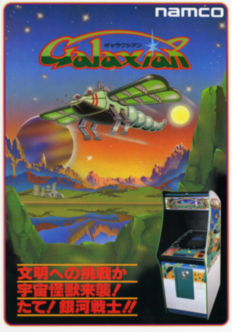
Galaxian is a 1979 fixed shooter arcade video game developed and published by Namco. The player assumes control of the Galaxip starfighter in its mission to protect Earth from waves of aliens. Gameplay involves destroying each formation of aliens, who dive down towards the player in an attempt to hit them.
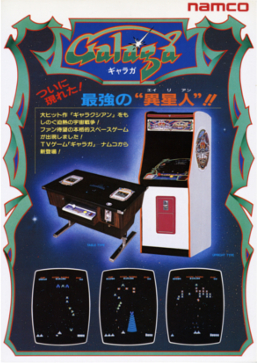
Galaga is a 1981 fixed shooter arcade video game developed and published by Namco. In North America, it was released by Midway Manufacturing. It is the sequel to Galaxian (1979), Namco's first major video game hit in arcades. Controlling a starship, the player is tasked with destroying the Galaga forces in each stage while avoiding enemies and projectiles. Some enemies can capture a player's ship via a tractor beam, which can be rescued to transform the player into a "dual fighter" with additional firepower.

Dig Dug is a maze arcade video game released by Namco in 1982. It was distributed in North America by Atari, Inc. The player digs underground tunnels to attack enemies in each level, by either inflating them to bursting or crushing them underneath rocks.
In video game parlance, a multicart is a cartridge that contains more than one game. Typically, the separate games are available individually for purchase or were previously available individually. For this reason, collections, anthologies, and compilations are considered multicarts. The desirability of the multicart to consumers is that it provides better value, greater convenience, and more portability than the separate games would provide. The advantage to developers is that it allows two or more smaller games to be sold together for the price of one larger game, and provides an opportunity to repackage and sell older games one more time, often with little or no changes.

Rally-X is a maze chase arcade video game developed in Japan and Germany by Namco and released in 1980. In North America, it was distributed by Midway Manufacturing and in Europe by Karateco. Players drive a blue Formula One race car through a multidirectional scrolling maze to collect yellow flags. Boulders block some paths and must be avoided. Red enemy cars pursue the player in an attempt to collide with them. Red cars can be temporarily stunned by laying down smoke screens at the cost of fuel. Rally-X is one of the first games with bonus stages and continuously-playing background music.
Namco Museum is a series of video game compilations developed and published by Bandai Namco Entertainment for home video game consoles. The first title in the series, Namco Museum Vol. 1, was released for the PlayStation in 1995. Entries in the series have been released for multiple platforms, including the Game Boy Advance, PlayStation 2, PlayStation Portable, Nintendo DS and Xbox 360. the latest being Namco Museum Archives Vol. 2, released in 2020.

Galaga '88 is a 1987 fixed shooter arcade video game by Namco. It is the third sequel to Galaxian. It features significantly improved graphics over the previous games in the series, including detailed backgrounds, larger enemies and greater ship details. The game runs on Namco System 1 hardware.
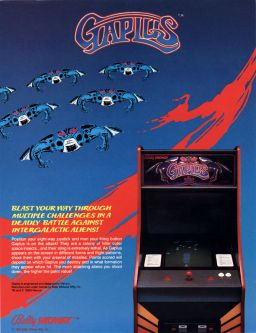
Gaplus is a 1984 fixed shooter arcade game developed and released by Namco. It is the third game in the Galaxian series, serving as a direct sequel to Galaga (1981). In North America, a modification kit was later released to change the name to Galaga 3, possibly to reflect its position in the series. It was the only game other than Phozon to run on the Namco Phozon hardware. A contemporary home port for the Commodore 64 was released in 1988. A "demastered" version of the game was included in Namco Museum Archives Vol. 2 as a bonus title.
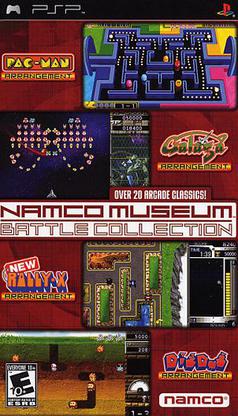
Namco Museum Battle Collection is a 2005 video game compilation developed by Tose and published by Namco for the PlayStation Portable; the first Namco Museum since the PS1 series to be developed in Japan. It includes 21 games - four of these are brand-new "arrangement" remakes of older Namco games, while the rest are emulated ports of Namco arcade games from the 1970s and 1980s. These ports include an options menu that allows the player to modify the in-game settings, such as the screen orientation and number of lives. Players can send one-level demos to a friend's console via the "Game Sharing" option in the main menu.

Namco Classic Collection Vol. 1 is a 1995 arcade game compilation developed and published by Namco. It includes three of the company's most well-known games from the early 1980s — Galaga (1981), Xevious (1983), and Mappy (1983) — alongside brand-new "Arrangement" remakes of these games that have updated gameplay, visuals, and sounds. The arcade originals are also modified slightly to end after a certain number of rounds. Super Xevious (1984) is also playable. It ran on the Namco ND-1 arcade system, being one of the first games to utilize it.

Namco Classic Collection Vol. 2 is a 1996 compilation arcade game developed and published by Namco. It is a collection of four of Namco's popular games: Pac-Man (1980), Rally-X (1980), New Rally-X (1981) and Dig Dug (1982). Alongside the original games, three new "Arrangement" games based on each game are included.
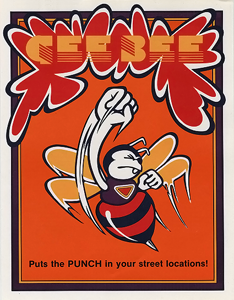
Gee Bee is a block breaker/video pinball hybrid arcade game developed and published by Namco in 1978. The player controls a set of paddles with a rotary knob, with the objective being to score as many points as possible by deflecting a ball against bricks, pop bumpers and other objects in the playfield. It was developed by Toru Iwatani, known as the creator of Pac-Man and Pole Position. Outside Japan, it was published by Gremlin Industries.

Cutie Q is a 1979 block breaker/video pinball hybrid arcade game developed and published by Namco in Japan. The player controls a set of paddles with a rotary knob, the objective being to score as many points possible by deflecting a ball against blocks, ghosts, spinners and other objects on the playfield. It was designed by Shigeru Yokoyama, with spritework done by Toru Iwatani. It is the third and final game in the Gee Bee trilogy.

Namco Museum Remix is a 2007 video game compilation developed and published for the Wii by Namco Bandai Games. The compilation includes nine Namco arcade games and five "remix" games made specifically for this compilation. A remake, Namco Museum Megamix, was released exclusively in North America on November 26, 2010; the game features nine other arcade games alongside the titles from the original, as well as an additional remix game based on Grobda.

Namco Museum DS is a 2007 video game compilation developed by M2 and published by Namco Bandai Games. The game features 7 arcade games previously published by Namco along with a Nintendo DS version of the Nintendo-developed title Pac-Man Vs.
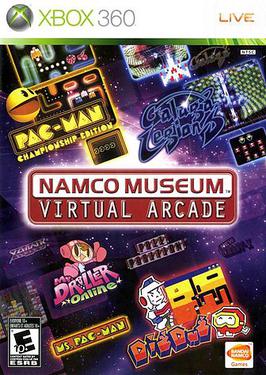
Namco Museum Virtual Arcade is a video game compilation developed and published by Namco Bandai Games for the Xbox 360. It was released in North America in 2008 and in Europe and Japan in 2009. Part of its Namco Museum series, Virtual Arcade includes 34 titles; nine of these are Namco Bandai-published Xbox Live Arcade games, and the rest are arcade games that are only accessible through the disc. Players can access the Xbox Live Arcade games through their dashboard if the disc is in the console.
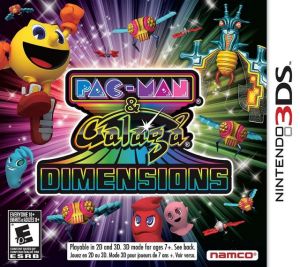
Pac-Man & Galaga Dimensions is a 2011 video game compilation developed and published for the Nintendo 3DS by Namco Bandai Games. It contains six games from the company's Pac-Man and Galaxian franchises—Pac-Man (1980), Galaga (1981), Pac-Man Championship Edition (2007), Galaga Legions (2008), Pac-Man Tilt, and Galaga 3D Impact, the last two being unique games created exclusively for this collection. The collection also includes achievements, online leaderboards, and a trailer for the Pac-Man and the Ghostly Adventures television series.

Namcot Collection, also known as Namco Museum Archives, is a 2020 video game compilation published by Bandai Namco Entertainment. Originally released in Japan for the Nintendo Switch, it was localized for international territories as two separate collections, Namco Museum Archives Vol. 1 and Vol. 2, for the Switch, Xbox One, PlayStation 4, and Windows. Namcot Collection includes a wide array of video games published by Namco for the Family Computer and Nintendo Entertainment System, with save states, achievements, and homebrew ports of Pac-Man Championship Edition and Gaplus.

















